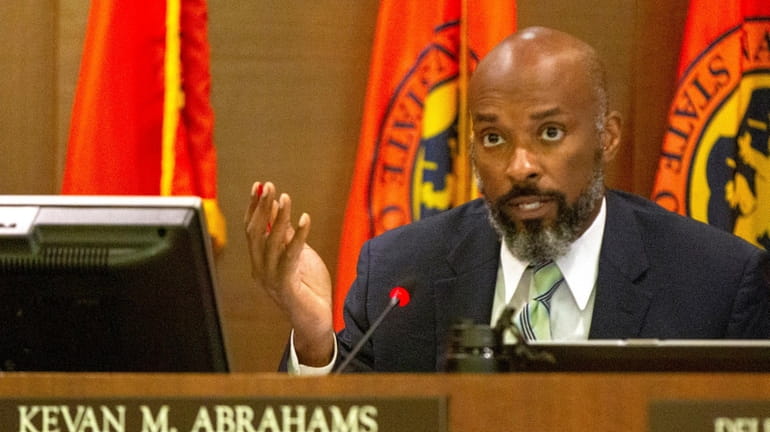This time, police reform on Long Island may be an open process

Nassau legislator Kevan Abrahams during committee meetings at the Nassau County Legislature on Oct. 7, 2019 in Mineola. Credit: Howard Schnapp
Two — no, make that three — county lawmakers introduced measures over the past two weeks to jump-start the police reform process in Nassau.
Legislators Kevan Abrahams and Siela Bynoe, both Democrats, sent up a resolution to create a 24-hour toll-free hotline and website for reporting allegations of police misconduct. The resolution also calls for creating a detailed log of complaints that would be accessible to the public, with names of officers in unsubstantiated complaints redacted.
A week or so later, Bynoe and Legis. Joshua Lafazan, an independent who caucuses with Democrats, put forth another resolution — for a study to consider new ways for police to handle encounters with mentally ill people — which could include having mental health professionals respond to such calls with police.
All the measures, lawmakers said, were in response to protests, across Long Island and across the world, after the death of George Floyd in Minneapolis.
Abrahams, the legislature's minority leader, said he and other lawmakers have been discussing potential police reforms, and that he considered the proposal for a hotline — which would be administered by a third party — necessary. "We were looking at something that would build in more accessibility, more transparency and more accountability," he said.
That accountability would stem from another portion of the resolution that would charge a Nassau deputy county executive with overseeing the county police department. The official would appear before county legislators several times a year to brief them on the kinds of complaints being lodged against police.
Abrahams said he had hoped that the resolution would make it past the Rules Committee of the Republican-led legislature.
It didn't.
But the proposed commission put forth by Bynoe, of Westbury, and Lafazan, of Woodbury, did.
One reason for the lack of action on the hotline and other related items, according to Legis. Richard Nicolello (R-New Hyde Park), the presiding officer, is that "I don't think we should be dealing with this issue piecemeal."
He said he preferred to wait for County Executive Laura Curran, a Democrat, to send her proposed plan for reforming the police department to lawmakers first, so they could consider the plan in full.
Even so, there's no guarantee that what Abrahams and Bynoe want will be included in Curran's plan.
But, under an order signed last month by Gov. Andrew M. Cuomo, the county executive's office, the police department and fellow lawmakers will, at minimum, have to listen to the community.
Under the order, every municipality in the state with a police department is supposed to submit a plan that "reinvents and modernizes police strategies and programs in their community based on community input."
Municipalities also will have to certify that they devised their plans as part of a "public and open process."
That in itself changes the usual dynamics of government response to any crisis, which too often goes like this: A) Something awful happens. B) Residents get mad, and get loud. C) Government promises change, which often comes packaged in proposals drafted behind closed doors.
Not this time — at least in theory.
In Nassau, a spokesman for Curran said she intended to open up the process by working with a panel that includes one of the young people who have been protesting in Nassau, and taking their views into account when she and the police department draft the county's reform plan.
From there, the plan will be released online for public feedback — and then brought back to the committee for review, which could include adding suggested changes.
Under Cuomo's order, the revised plan then would go to the county Legislature, which must approve it.
At that point, there would be at least one public hearing before lawmakers vote on the plan.
In Suffolk, Robert Calarco, the Legislature's presiding officer, wants lawmakers involved in the process — even as County Executive Steve Bellone and the police department begin drafting the county's reform plan.
"I don't think it's best to wait to see what the plan is," said Calarco (D-Patchogue). "And I believe the county executive would want some buy in before it came our way."
A spokesman for Bellone, a Democrat, said Suffolk had yet to complete a structure for how the county will "solicit input from stakeholders and produce recommendations for consideration."
Either way, the mandate for transparency and community input is extraordinary.
Calarco said he has never seen a mandate for such an open process before.
"It's a big job, it's an important job, and we don't have a lot of time," he said, referring to Cuomo's April 2021 deadline.
In interviews, emails and telephone calls over the past few weeks, police officials, a few union members, some officers and several police supporters have made it known they consider it wildly unfair to lump Nassau and Suffolk police in with other departments, including Minneapolis, where four former officers have been charged in Floyd's death.
Bynoe agrees.
"Nobody is saying they are the same," she said, "but that doesn't negate the fact that there is significant momentum for change."
Next year, Curran, whose administration has yet to reach agreement with police unions on new union contracts, will seek reelection. So will Nassau and Suffolk County legislators.
Traditionally, candidates covet support from Long Island's politically powerful police unions — which, it bears mentioning, also are to be included as stakeholders in the police review and reform process.
Does Calarco worry whether his work on a plan could impact his race?
"No," he said.

